
DET VAR VÄRT ETT LIV
Självbiografi av Bernhard Kauntz
Roadtrip through Scotland
Three o'clock in the morning is not a very unusual time for me, to go to bed. But this time it was different. I had to get up at 3 a.m., because the taxi was ordered for an hour later. It would take me downtown to the bus to the airport, which in turn would deliver me there at 5:40, even though my plane wouldn't leave before two and a half hours later. As every time, when travelling I was rather fed up with starting five hours earlier, in order to get the not fully 100 kilometers to the airport.
Alas, a little compensation was, that I really was looking forward to my first visit in Scotland. When I had been in Belgium earlier this year, Braem had invited me to follow him, Cere and Greg to Scotland later this autumn. Of course I had accepted. That was the reason why I, rather late in autumn, mid-october, was on my way to Edinburgh. Due to the timedifference i landed still rather early at 9:30. As the others wouldn't arrive before the afternoon I had some time of my own. I took a bus downtown and started walking to our hotel.
The only trouble was, that the bus station was down at the river, whereas our hotel, the Hilton Edinburgh Carlton, lay almost on top, near the Royal Mile, leading to the Castle, the highest point.
|
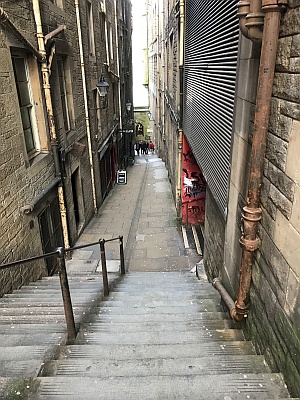 |
But as I was on my own, I took it easy and with many pauses, I finally made it. The hotel was classy. I explained that I was first of our group, but that I would wait for the others. The staff was well educated - and friendly. They gave me the feeling, that they really cared about me and my stay and not only did their job. The room wasn't ready yet of course, so they took care of my luggage, which I later found back in our room. But now I had time to do things on my own. Just around the corner was the Royal Mile. I thought, that I still would be able to walk the last hill up to the castle. On the way I passed the Edinburgh cathedral, which I couldn't just pass by, without having a look inside. It is consecrated to St. Giles, even if it has been a protestant church since the 16th century. John Knox, shown as a statue in one corner of the church, had the lead in the Scottisch reformation.
I am not very fond of churches taking paid for visiting, as I think, that it is the purpose of a church to be open for people, as a place of devotion and as showcase of culture. Of course, even museums take an entry fee, but anyhow, I think there is a slight difference. Here they had found an acceptable solution, as the right to make photos was sold for two pounds. And again, I was surprised by the friendlyness of the people.
|
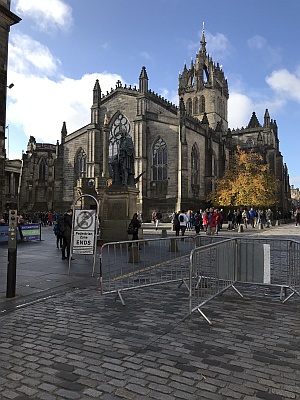 |
If I ever get the time, I shall write a special article about St. Giles. Let me just mention, that you can meet historical persons like the author Robert Louis Stevensson (Treasure Island) or Walter Chepman, who introduced printing in Scotland. Finally I must mention the Thistle Chapel. It is a place of meeting and worship for the monarch and 16 leading Knights or Ladies. Even Members of the British Royal Family and foreign monarchs are accepted as "extra" members. The thistle is the national flower of Scotland, by the way. There is a legend about how the thistle became the National Flower. It helped to resist an invasion of the Vikings at a battle. The Vikings' ships arrived in the middle of the night, in order to surprise the locals. But they were greeted by a field of sharp thistles. As many of them wore only sandals, their screams and curses woke up the Scots, who then could fight off the attack.
Out in the street again I met David Hume, the Scottish philosopher, and came to think of how many internationally important British people actually are Scottish.
Now it was time for lunch, but all the seats in the restaurants were taken.
|
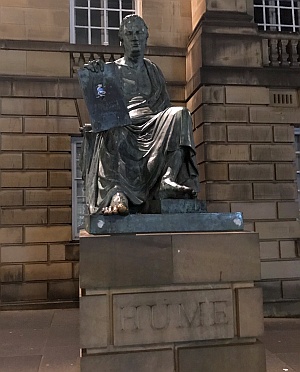 |
Finally I found a place with a more expensive look - but I had already fallen in love with this city, so what the h...?
Again I noticed the friendliness of the numerous staff, not only asking about the dishes, but also about my wellbeing.
I had a really nice time, with a starter, that could have served as an entire lunch. The glass of wine cost as much as I else would spend for a meal. I remembered a saying of my father: "If the cow is gone, the calf might go as well" and ordered a French coffee afterwards, just to see, if they knew how to make it. It was a little too little whipped cream, but the rest was o.k. Maybe I should have taken an Irish coffee instead, but I prefer the Grand Marnier in it and there would be plenty of time to test the whisky of Scotland later.
|
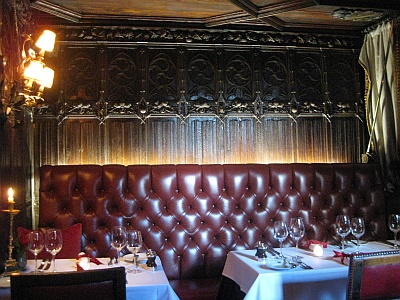 |
|
Back on the Royal Mile I was fascinated by the small tunnels through the houses, called "close", connecting two parallel streets. And of course, as the Royal Mile is the most important tourist street, there are artists, pipers, vendors and some of whatever you can imagine. But the tame eagle owl impressed me most. (Note to my friends: Be quiet, guys!)
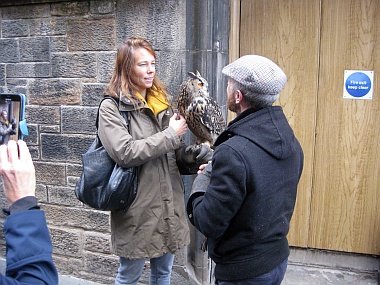 |
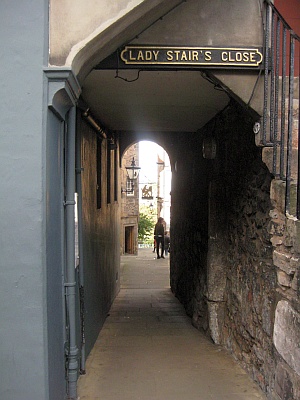 |
|
Finally I hade made it up to the castle. It is a nice sight from outside and it is interesting from the inside as well. From there you have a marvellous view over the Firth of Forth and on the other side over the Old City.
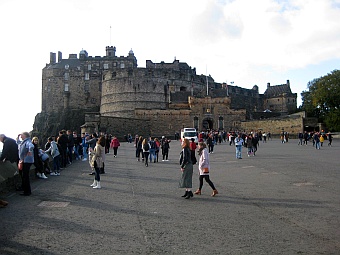 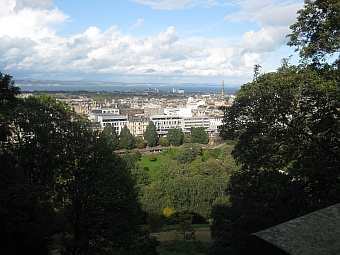
|
But there is more. The different parts of the castle are all more or less used as museums for special sections, that fit into a castle. The jail tried to give an impression of how prisoners of war were kept in old times. The King's Palace showed the furniture of the monarchs' rooms as well as dublicates of the Scottish Crown Jewels, and so on. But one would need a whole day, to really visit every exhibition. Then maybe the entrance fee of twenty pounds would also be fair, even if I think that those fees in general are quite high in Scotland.
I can't go into details, as what to see in the castle, but there is one important thing, that I want to show. In an exhibition over battles that the Royal Scots fought, it states that Austria and Prussia declared war on France in 1792.
|
|
The history, which I know, says that it was France, which, on April 20th, 1792, declared war on Austria. This is backed up by the German and Swedish Wikipedia and my books on history. Funnily the English Wikipedia supports the Scottish version. This is maybe not very important today, other than it shows that there often are various truths about history.
|
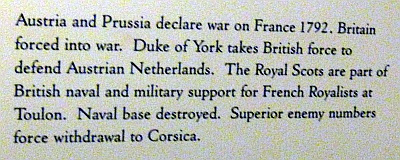 |
I went slowly back to the hotel and waited there for the guys. When we finally came into our room, we had another surprise. All right, it was a room for four, but in two double beds. That was not really, what we had expected ... In order to come over the shock, we went to the hotelbar to meet friends of Greg and Cere, who had come to Edinburgh just for seeing us. Glenn and Kathy were nice poeple - we spent the evening together, dining and later on walking from bar to bar. Before the evening was over, we had got a first taste of quite some distilled Scottish work of art.
Later on we managed even through the night, in spite of having an new and unaccustomed bedpartner.
|
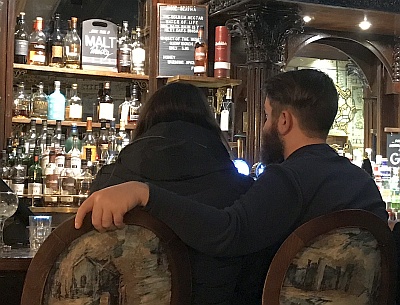 |
|
The next morning, after breakfast, our roadtrip began. It was clowdy, but didn't rain, so we were quite happy with the weather. We were heading for the Highlands, and yes, the scenery was impressive. The top of the hills were sometimes hidden by clouds, and togerther with a lake here and there we got marvellous views.
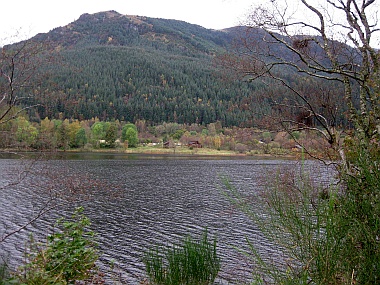 |
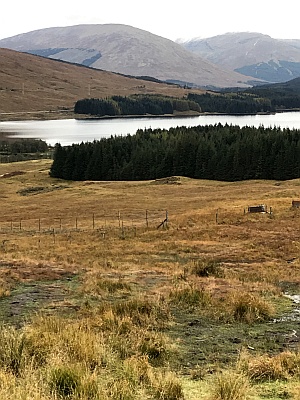 |
I wonder, why many hills are deforested entirely or at least to a large extent. On the picture to the right, you can see the partly naked hills. On the other hand, there grow trees on other hills, so it can't be because of the height ...
Braem suggested that we should take a break at a town called Stirling, where we could have lunch. There was also a small castle, but the entrance fee of fiteen pounds didn't make it look worthwile. So we walked downtown again, where even the church was closed.
|
Finally we ended up in the jail. This was presented very nicely in form of a guided tour, disguised as a form of rollplaying.

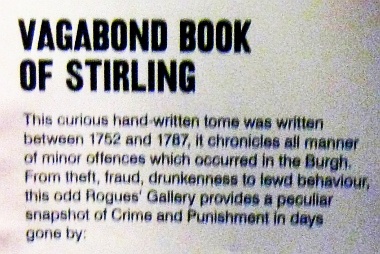 |
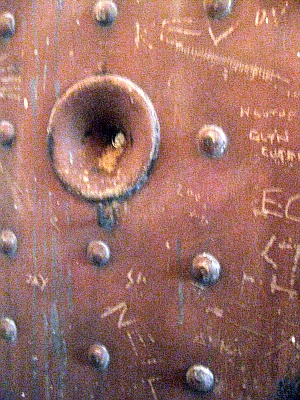 |
There was quite some difference to how people were thinking, at least Sydney Smith in 1821, compared to the hotel-like prisons we put our days' criminals into ... On the other hand, if you see the cells and mark the scribblings engraved in the metal door, you understand that even without extra punishment it wasn't even nearly hotel-like. In spite of that the jail of Stirling was the most modern of its time. And yes, there are some points in the regulations, that seem to be rather humane: "No prisoner should have his hair cut, against his will, exept when necessary for health." Or: "No prisoner shall be kept in a seperate cell when the Surgeon is of opinion that it would be dangerous to his health or mind."
Actually the visit in jail makes you reflect about the worth of punishment and the intent to make prisoners lawful members of society. There will always be different opinions about that, but it doesn't hurt to have thought about it.
Anyhow, that tour of about an hour was really worth the time spent there.
The worst was, that we now had to climb all that way, that we had been going downtown, in order to get back to the car. I can do it only very slowly anymore and it felt bad, to slow down all of us. Still, I fixed that too and soon we were going on to Kinlochleven, where we would stay our second night.
|
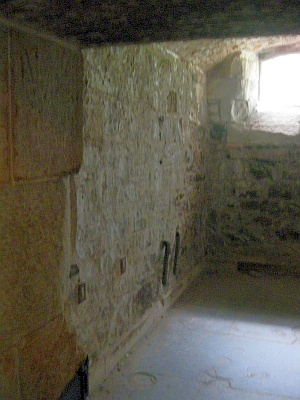 |
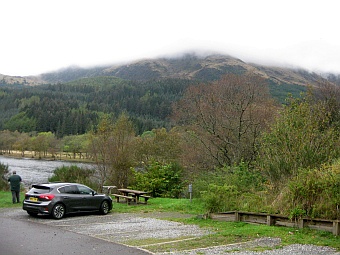 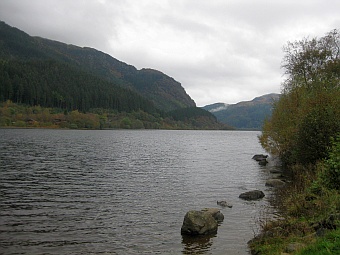
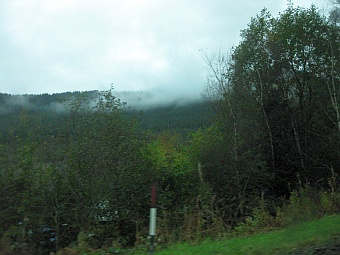 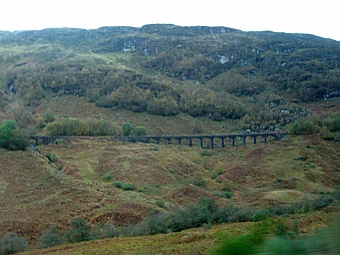
We passed even more stunning views, drove all along the Loch Lomond, known from the famous song. We stopped now and then for taking pictures. Of course the views were much better in nature, but even if it just was water and hills, there was an unbelievable diversity. It was also amazing to find an aqueduct out there. Who built that and where did it lead to? It couldn't be from Roman times, as the Romans didn't get this far to the North.
And then, at the next stop, it happened. There was a small waterfall at the bottom of a slight slant - and I wanted to get a nice shot of it. There was some sort of path with a big stone about halfway. So I stepped over the stone. The trouble was only, that the ground behind was muddy and slippery. Well, I didn't hurt myself, but for my trousers there was no more hope on this journey. I couldn't even get into the car, without making everything dirty.
|
| The car, by the way, had been rented by the agency, which had put the trip together. It was a comfortable, almost new Passat, so travelling in it was no problem even for longer distances. Luckily enough, I had packed a pair of old reserve trousers, so I changed at the side of the road (probably to the amusement of the passers by), and the problem was solved for the moment.
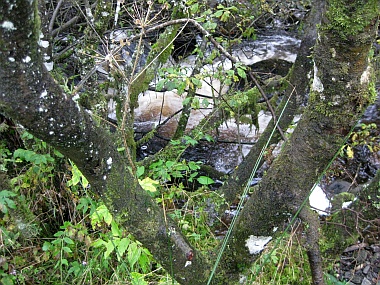
| 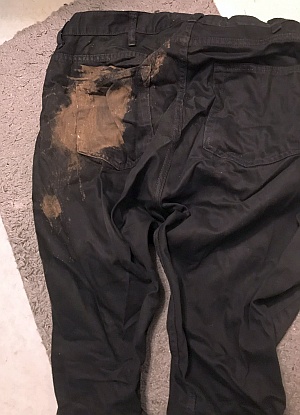 |
|
We passed more sights and took more photos. On the photo to the right there are two of "the three sisters", near Glencoe Village. A trickle of water is coming down between them, but I can imagine, that it becomes more than a trickle, if it rains for a whole day. The hills became eventually higher and were now almost to be called mountains. But all our stops made, that it nearly was evening, when we arrived in Kinlochleven. We lived in one room again, and this time we had four beds, which felt like a little relief. There was a big disappointment though, at least for me. On their webpage it said, that they had both a pool table and a dartboard. Right now they had reorganised the pub and would put back the sports items the following week.
|
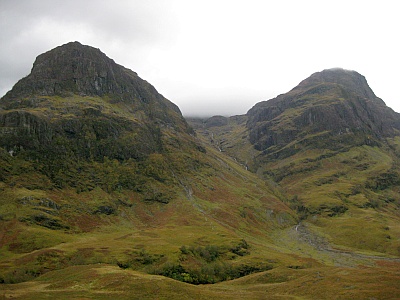 |
Strangely enough, we didn't find any other place with dartboard, wherever we went, during our whole stay ... That meant that I had paid forty Euro for nothing for my luggage, as I couldn't take it as handluggage with the darts in it. We ate at the Inn and then we took a stroll through the village. There were two other pubs and in one of them the was a pool table. So I had a game against Braem and I actually managed to force him to a decider, before he beat me 2-1. We went to bed rather early after another great day.
After breakfast our first issue was to get new trousers for me, as the old ones I wore, were not really outstanding. We did so in Fort William, from where the highest point of the British Islands can be seen - Ben Nevis.
|
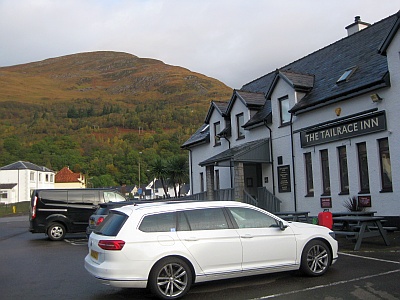 |
|
It reaches a height of 1345 meters. Just outside Fort William, there is a castle ruin after Inverlochy Castle, which has barely been altered since the Wars of Independence, that is to say in the 12th and 13th century. The description on various plates is in English as well as Gaelic. It is very difficult to find any resemblance from any other language to the latter one. The numerals bear a faint likeness, insofar as the number three is "trí", so as in many other languages: tre, drie, drei, tri, tres, trois, dri, etc. Even the number eight "hochd", starting with a vokal - if the "h" isn't pronounced - is very spread (åtta, acht, otto, ocho, huit). There is, on the other hand some English assimilation to Gaelic: Glen certainly comes from "Ghlinne". By the way, "The (great) Glen" is the denomination of the deep valley between Inverness and Fort William, due to a shift of landmass a couple of million years ago.
|
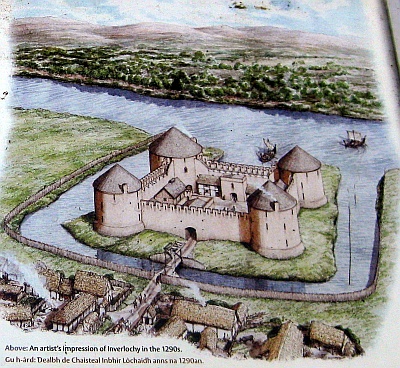 |
|
The castle was placed stratecigally att the south end of the Glen, in order to control the area. Just because of its place, it was frequently visited by merchants and soldiers. The builder of the castle was John Comyn, leader of Clan Comyn. But as he competed for the throne and his opponent, Robert the Bruce, won, the Comyns were expropriated.
|
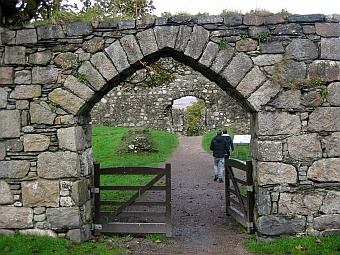 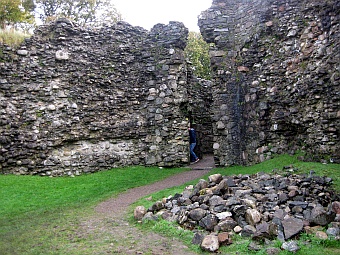
After that, there were many different owners through times. There were even two mayor battles near the castle. In 1431 the army of King James I was beaten, but in 1645 a royaliust army was victorious.
The northwestern tower was a little bigger than the other three and served as keep, or "donjon" for the reigning families. It is 6.1 meters across and 7.6 meters high. It consisted of four floors, each corresponding to a different room of an apartment of today. Stables, kitchen and bakehouse were built in the courtyard.
|
From the castle we went to the Ben Nevis distillery, where we participated in a guided tour. We were to see the basic production and got a picture of how very important the treatment afterwards is, in order to get the right flavour. Looking at all the barrels, lying around, filled with whisky, gives you a strange sensation, which bleakes though, when you hear, that there are 70.000 more barrels inside the storehouse, waiting to reach the right age.
With a smile our guide explained, that the water they used was collected directly from Ben Nevis through big pipes. And he said, that they didn't mind, that they lived in a rainy area, because "more rain means more whisky".
|
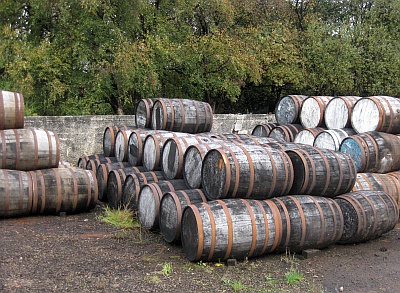 |
After the distillery we got into the car again and took off for a sidestep. We were to go to the island of Skye, the biggest island of the Inner Hebrides. Before we reached the island, we stopped at an inn and had a very nice lunch, made by an Indian cook and served by a Brazilian waitor. Last not least it was the environment, that contributed to feeling well. The photo to the right I took from the chair, where I sat at the table.
The island is connected with a bridge to the mainland. As there is no straight road, but the roads follow mainly the coastline, it took some time to get to our next stay. This was a very fancy hotel in Skeabost, about fifteen minutes away from Portree, the main (and only?) city on the island.
|
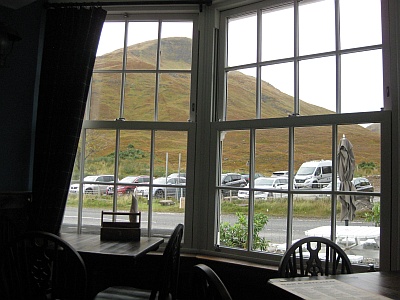 |
This was the only place, where we didn't have a room for four, but only two doubles. As Cere and I were accused of snoring, Braem and Greg had decided that they would share one of the rooms. Both rooms had double beds again, by the way. I had bought earplugs, just in case, but I didn't even open the package. And yes, I heard a snore now and then, but it couldn't have been that bad, if I never got tempted to take out the earplugs.
The view from the window in our room was smashing. On the other hand, I am not sure if it was worth another three hours drive, just for looking at some more hills and water. But then again, probably I still wouldn't know, what a Cranachan is, nor what it tastes like.
|
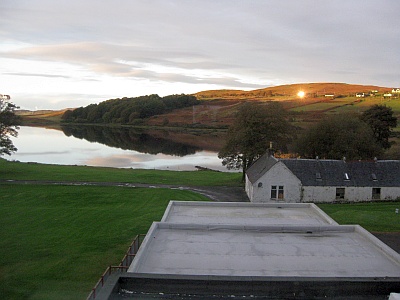 |
The guys wanted to stay at our hotel and have dinner there, but I voted for going back to Portree. It would be dark soon and what would we do out there, far from everything, apart from sitting in the bar? Luckily I convinced at least Braem and Cere, so after a drink, which Greg needed two hours for, we went back to Portree. It was rather late now, everybody was at dinner and there was no free table to be found. Finally we found the Tongadale Hotel, with empty seats in the restaurant.
When we had eaten, our beautiful waitress asked if we would like some dessert. As I almost never eat sweets, I was not too interested. But when she talked about the Cranachan, I started listening. New things, and especially local things, are always worth to be tried out. And as our waitress described this traditional Scottish dessert so nicely, I decided to have one. And indeed, that mix of whipped cream, raspberries, honey and other things was a nice experience. So, when I had finished, I asked her, if I might take a picture, as I would put this episode into my biography. When I hade taken the picture (which didn't turn out well, as it was too dark), I asked her name. "You must guess it", she said. "It is Hungarian but also French and starts with a B."
|
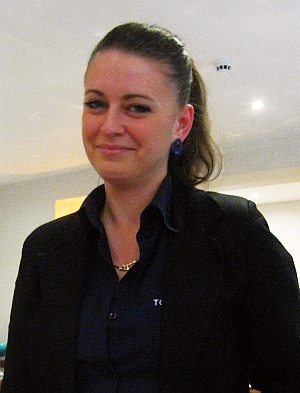 |
The four of us started guessing, but it took some time before Cere finally got it right. Bernadette. I had thought of that, but I thought, it would have been to big a coincidence, being named Bernhard myself ...
Anyhow, thank you so much for a really nice evening, Bernadette! This was one of the golden moments in life, which one remembers.
When I paid and looked at the bill, I noticed that her name was printed there anyway (and she must have known that, so she was just teasing). But there was something else I had noticed before, and which again shows the friendliness of that people up there. They put "Thank you" on top of the note - in handwriting. That is a very nice gesture. When I saw, that Bernadette also had written "Danke schön" on the bill, it took me almost off my feet. And I regretted, not to be fourty years younger.
|
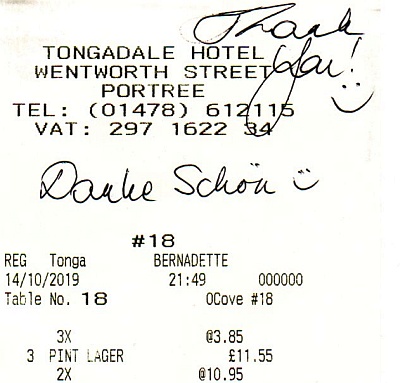 |
After a maximum, there will always be a minimum. Next day I learned, that we would have to go back to Fort William, the same way we came, and first afterwards turn North, to reach Inverness. I had said from the beginning, that it was nice just to be following in a small group, instead of having to do all the planning - and I had meant that. But there is a limit. So, when Greg proposed, that we should take a turn around the northern end of Skye (which according to the touristinfo would take an hour and a half, which, counting in all the stops would be closer to three hours), I had to protest. Yes, the scenery was nice, but now we had had two days of hills and water. Surely there would be some nice nature to see on the way to Inverness as well. But I can't help that cultural things are as important to me, as any nature. Nature has been there all by itself, whereas all culture is an accomplishment by mankind. And taking delight of cultural things, could surely be more ideagiving than looking at more stone and water? I pitied Braem, as he was to make a decision. He did it wisely through a compromise. We would go to a certain point on that roundtrip to the north, but then return. Well ...
|
|
And yes, of course, there were more nice views, but all of them on the same theme, rock and water. Eventually we turned the car and rode all the way back to Portree and continued to Port William. In my opinion, that day to Skye was a lost day. It was just many hours of driving.
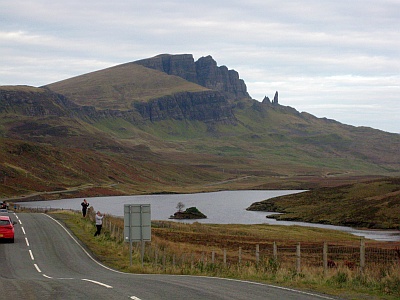
|
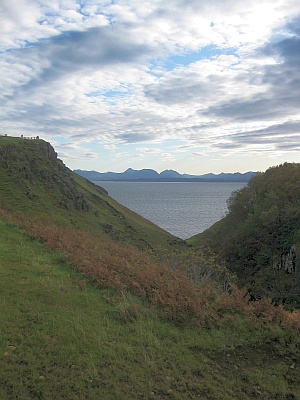 |
We had been living very fashionably on Skye, but far away from everything. And it didn't introduce anything very different either. Apart from Bernadette, of course.
On the other hand you learn new things every day, being in a foreign country. I learned for instance, that the Bank of Scotland is allowed to print its own money. It is (theoretically) valid in all of Great Britain, but has different motives. As with all British money nowadays, it is impossible to tear apart the banknotes, because they are made of plastic.
|
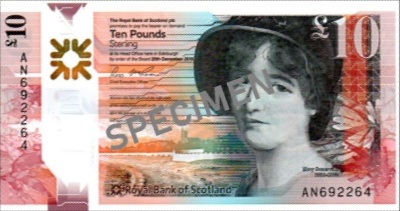 |
And now, as I wanted to show the difference to an English ten-pounds-note, my scanner refused to scan banknotes issued by the Bank of England! So much for being supervised, even if I understand that there must be restrictions in multiplying banknotes.
Early in the afternoon we passed the place, where we had had lunch yesterday. It had been a nice place, so we decided to eat there once more. Eventually we came to Fort William and could finally turn north, the road leading along the Loch Ness.
But my surprises for the day were not over yet. After a while we passed Urquhart Castle. There were a lot of reasons, why I wasn't really interested of it. It was a lot of walking up and down, just in order to get there.
|
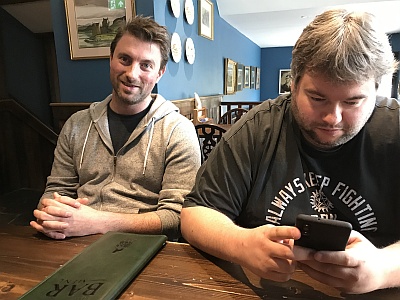 |
Besides we had seen a castle ruin yesterday. This one was bigger and a prettier view, but the janitor would have been sitting near the entrance and the biggest tower would have been the owner's living area. Then I thought, that a generation, growing up with images, be it on TV, films or even on facebook, probably was more dependent on views, than on content. Without reading books your imagination becomes underdeveloped. Therefore places with a view will always attract most people, even if there is nothing new to learn. Yesterday we had been more or less alone, when visiting that castle.
But there was more, talking against visiting. Yesterday it had been for free, here they would charge twelve pounds.
| 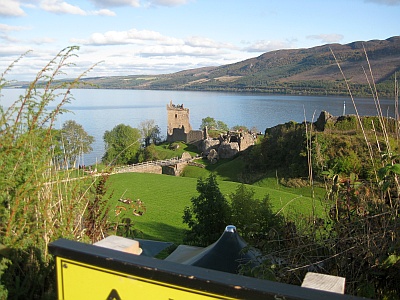 |
Anyhow, it would be difficult to make nice photos with all those tourists.
And finally, I was convinced that there would be more interesting things to do in Inverness.
When Greg and Cere said, that they would like to see the castle, I told them that I would stay outside and wait for them.
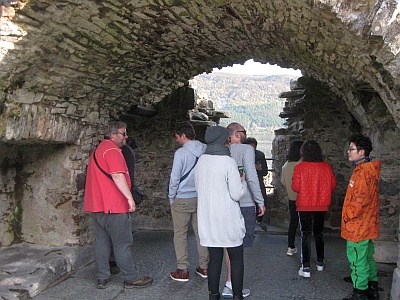 |
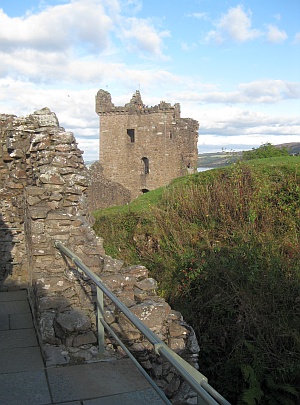 |
When they backed off and left it to me, to decide, I didn't want to keep them from seeing it. So I told them, that they really should go. We were talking near the entrance and the cashier overheard a lot of our discussion. So, when I stood aside, while the others were paying, she blinked at me and let me enter for free. Well, that is fate. The money hadn't been my biggest aversion, but it is hard to refuse, if people show kindness. So I found myself another hour of climbing up and down.
The history of Urquhart Castle was, with slight differences, much the same as in Inverlochy Castle, with a lot of fighting around it. There were fights for independence, heritage fights within families, religious fights and more.
|
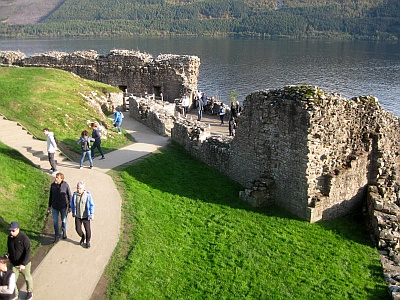 |
During the high time of the Clan Comyn, they owed both castles, meaning that they had full control over the southern part of Loch Ness. As there were not any streets worth mentioning, all traffic happened on the water, which put the Comyns into a very strong position.
Finally we got going again and eventually reached Inverness. Vi had rented a cottage in the Loch Ness Country House, but had still access to the facilities of the hotel, such as bar and breakfast. In the cottage there were two double rooms apart from a small living. It was a very nice place, but also outside of the city. It was rather late already, so we just dropped the luggage and went to have a look at Inverness. It was too late for visiting or participating in anything, which was a pity, as the local museum showed an exhibition about the Picts, the original inhabitants of Scotland. That would certainly have been something new. But all we could do was talking a stroll down Bridge Street, walking past the Town House and the Castle.
|
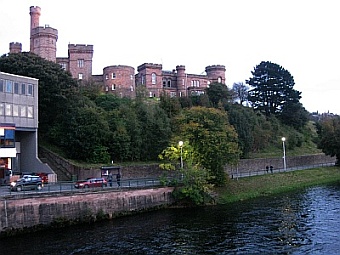 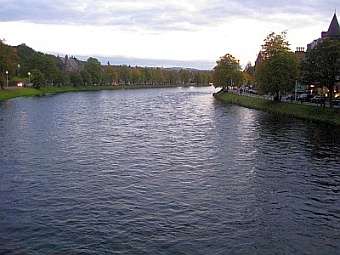
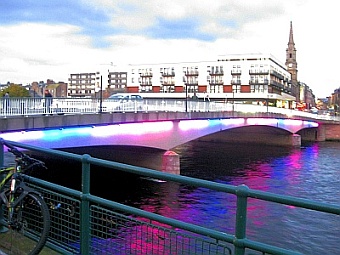 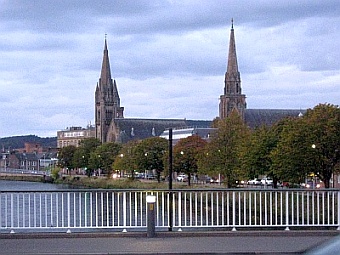
When we reached the bridge over the River Ness, I was very surprised over the speed, with which the water flew in its attempt to reach the North Sea. There was som nice illumination of the bridge as well and a rather strange sight. Two churches, almost similar, streched their gothic towers upwards against the sky, standing almost next to each other on the shore. We understood that it was a protestant and a catholic church - and I found it very positive, that those religions at least here in the end could coexist without fighting.
We had an aperitif in a pub across the river, went back over the bridge, had a nice meal and drove home again. Before going to sleep, we sat together for a while, having a last beer. Both Cere and I had caught a bad cough, so I didn't mind, that it was a little earlier when we hit the pillow.
I wasn't feeling too well next morning either, I think I also had some fever, but a little consolation was breakfast, with Eggs Benedict on salmon toast.
Our next stop was a pharmacy, to buy something aginst the cough. I had already paid, when my eyes fell onto a small, handheld fan, driven by batteries. It cost only two pounds and it will serve well, when I play darts. Sometimes it gets so hot, that you ache for every little bit of moving air.
|
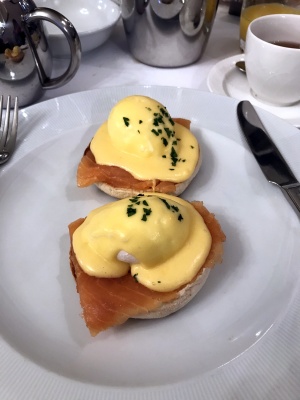 |
I got one of course, and then I thought that this was another example, why I was no good as businessman. Twenty pounds wouldn't have hurt, if I had bought ten of them. I think I could very well have sold them to other darters for three times the price.
Our next visit was at the Loch Ness exhibition. It was rather interesting, not at least the facts about Loch Ness itself. As I said before, the Great Glen, the deep valley, today mostly filled with Loch Ness water, came into existance, when the northern part of Scotland slid to the southwest along the rest of Great Britain, about 350 million years ago. The Loch is 36.6 kilometers long and down to 230 meters deep. To fill up its volume, one could put every living human being into it - and that more than three times! There was also a memory stone, to dignify John Cobb, who in 1952 reached a new speed record on water, but payed with his life, as the waves of his own securityboats tragically hit his vessel and made it capsize.
The rest of the guided tour was naturally enough about the Monster, which had been seen so often.
|
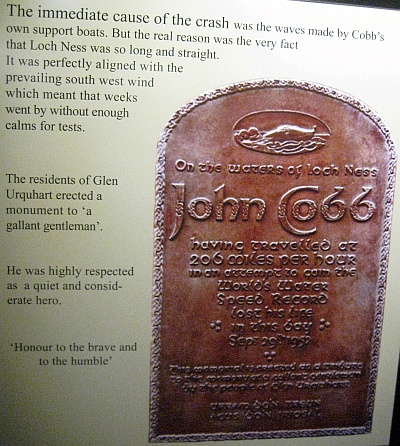 |
|
Already at the very first station, there is something looking out from the stone wall, which seems to be Nessie's grandfather. Much of the exhibition is of course about all the sightings, actually over one thousand, and many of them by really trustworthy people. The very first sighting goes back to the year 565, when the missionary Columban tried to convert the Picts. The trouble with the different reports is, that they vary quite a lot. Mostly it is a long sea snake with a long neck, but even different form of large fishes or reptiles have been seen. And none of those has a long neck ... On the other hand, there are films, showing for instance a large staff moving upright in the water, which could be taken for a long neck, seen in the distance.
|
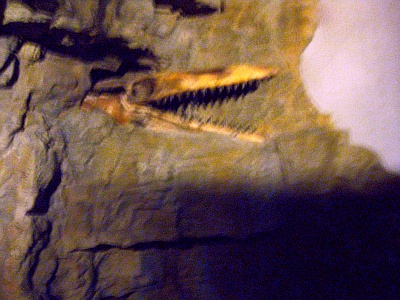 |
There are also the pros and cons for each type of possible animal, that could be Nessie. If the monster were a mammal, there would not be enough food in the Loch for such large a beast. If a fish, it could be a long eel, that hadn't found back to the sea. But then an eel has no long neck. If Nessie were a reptile, the water would be to cold. And so on. The exhibition doesn't take part in the question of Nessie's existence or not, but it describes all the investigations under water, that have been made. That ranges from simple underwater vessels to modern sonar examination of the Loch. So, the question remains open, even if there hasn't been any sighting since 1985. If Nessie has emigrated or died at that time, we shall never solve the riddle.
|
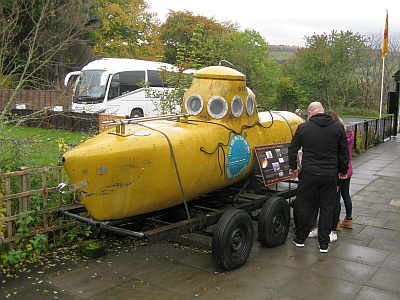 |
|
We visited another distillery, just to buy some more whisky. My cold didn't get better of the rain, that was falling all day, and my mood fell rapidly, when we came to Aberlour, trying to get some lunch. It wasn't many minutes past two, when we found the only restaurant in that metropolis - but the lady of the house declared, that lunch was served until two o'clock and not a minute longer. Full stop. (The clock on the churchtower showed ten past two, when we came out again ). So we had to go to a nearby café, where they didn't even serve beer. I was not amused. Besides, I got worse during the day, so I slept most of the time in the car. When we reached Aberdeen in the evening, we just ate dinner at the hotel. Braem and Greg took a stroll afterwards.
|
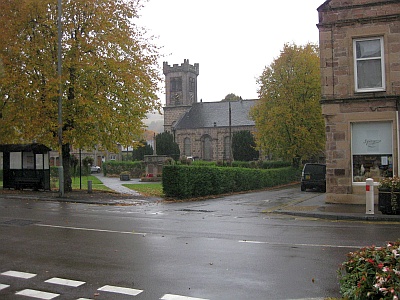 |
But as much as I would have liked to see a city, I thought it was better to stay at home. Thank God I felt a little better the next day, because I had to travel all day and wouldn't be at home before late in the evening.
Next morning we left after breakfast and went to Edinburgh, where we returned the car, checked in at the airport, had a quick lunch and then it was time for me to say good-bye, as my plane was due an hour earlier than theirs.
To sum up, it were some marvellous days. It was nice to be with the guys, even if I slowed them down sometimes. It was good the see the friendliness of the people and the awe-inspiring nature. And there were after all some new things, that I learned. One can't ask for so much more. Thank you guys, for the company!
|
© Bernhard Kauntz, Västerås 2019
Tillbaka till Innehållsförteckningen
Tillbaka till  av av 
Back to the  of of 
last update: 29.10.2019 by webmaster@werbeka.com
|





















